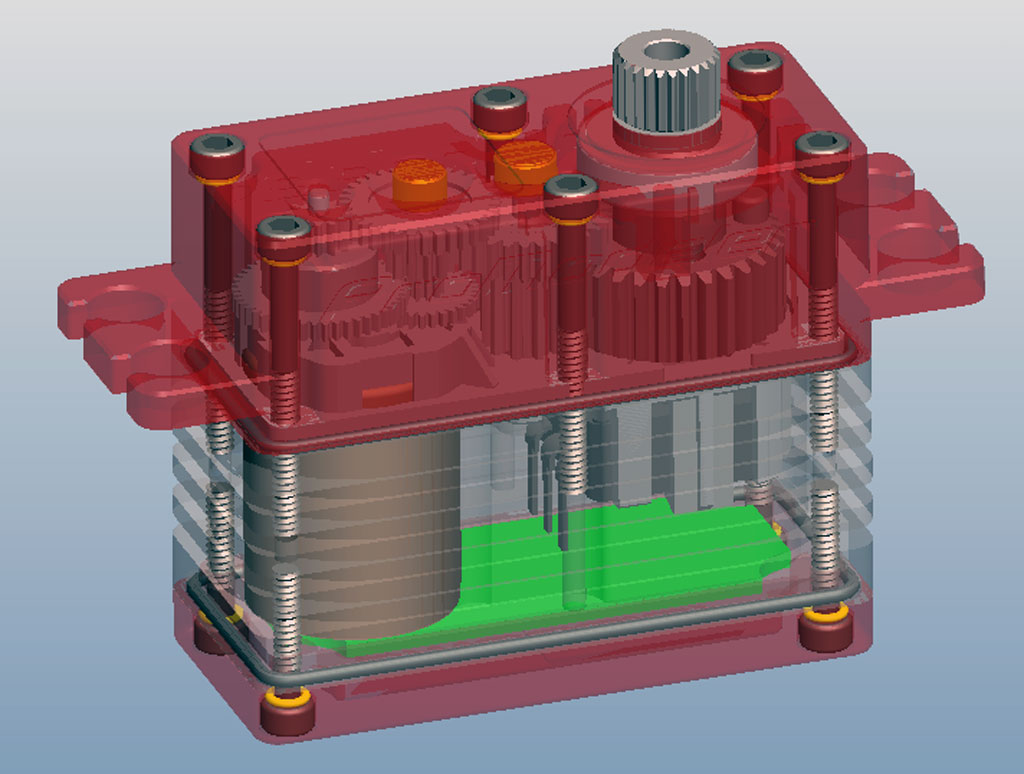As usual, these white papers begin with a query, this time from Jason, who writes . . .
Q. I'm looking to upgrade the servos in my Flex innovations Cap 232 60e. The stock mini-class Potenza DS34HV are rated at 90oz-in 0.12sec/60° and I've noticed the ProModeler DS100DLHV and DS90DLHV both match up torque-wise. I'm attracted to the DS100 because it's smaller and lighter, but the DS90, which has an attractive price, is slower. Will I notice this, or is one better than the other for me, and which would you recommend?
A. In reverse order . . . neither makes the recommended list for this model. This is because beyond torque and being a great value, there are other (mechanical) aspects modelers should consider. For example, you mentioned size and weight (and touched on price), but there's also speed, robustness, gear material, case construction, as well as current draw considerations which can result in the selection of 'best' more complex and difficult to nail down.
First, and as you astutely noted, the DS100DLHV is physically smaller and lighter than the stock servos, which is good. Second, and on the flip side, the DS90DLHV is larger and a bit slower. The size factor touches on both robustness and weight (affecting flying characteristics). Both should be considered as 'important' additional factors.
Anyway, and as it turns out, the reason neither makes my recommended list is when we go through various considerations, for a 60e size 3D-model, it works out I'm of the same mind as Flex. Basically, I believe they selected a mini-class size servo for good reason and this is where I am going to ultimately guide you.
And as a side note, other manufacturers of 60-class models like AJ Models and Extreme Flight also spec a mini-class servo for their models ranging from 60-69" wingspan and designed for 6S power systems using up to 17" props so Flex is in good company, capice

Thing is, just leaving it at 'use a mini' would shortchange what is actually a pretty good learning opportunity regarding servo selection, so let me explain my thinking. And note, quite honestly, selecting a servo is often dead nuts simple, but sometimes it ain't and a 60-size model is one of those edge cases, which can go any of several ways.
By this I mean depending on use, a 60-class model can be an especially difficult class of model to select servos for. This, because what a scale warbird requires is different from a sport model, different from a 3D model, different from a glider, and different from a trainer. Yet all of these have 60"-ish wingspans!
Since this isn't our first rodeo when it comes to answering this exact question, and in consideration of how selecting the best servo can occasionally be tricky, instead of giving you the answer straight away, I want to step through the considerations, which I go through. This, so you (and others reading) may learn some of ins and outs involved in servo selection for yourself.
So next, let's examine some of the factors involved and try to rank them. Turns out, with some evaluation we can strike a fairly sophisticated balance between size, torque, cost, speed, and robustness whilst also evaluating gear material, case construction, and current draw. Point being, once you're done reviewing these factors, you'll be better equipped to determine which servo best suites 'your' needs.

Note; before jumping in, I'm often struck by folks principally considering
torque when selecting a servo whilst largely ignoring speed, size, gear composition, and current demands. Is what it is as marketing has trained folks to only consider torque but trust me when i say torque is important but it's not the only consideration. We'll begin with size.
Size
In point of fact, while ProModeler servos output from 75oz-in through 2685oz-in, we actually offer five servos outputting torque in the 90oz-in range (I consider 90-115oz-in to be within the range).
- DS90DLHV (standard)
- DS100DLHV (micro)
- DS105CLHV (sub-micro)
- DS115CLHV (wing)
- DS110CLHV (mini)
While all five are in the 90oz-in class, we're achieving similar levels of torque to the decent mini-class servos used in the Flex Innovations CAP 232EX, we achieve this with five different frame sizes! So let's address frame size, first.
ProModeler servos are offered in several different sizes and shapes to include;
- Sub-micro = ~16-20g
- Wing = ~21g
- Micro = ~25g
- Mini = ~36-44g
- Standard = ~71-90g
- Midi = ~210g
- Mega = ~370g
Moreover, we do it with three different types of motors;
That, along withconstruction, which varies between;
- Hybrid (alloy/polymer)
- All-alloy
Note; review this if you're curious about motor types - About RC servo motors
So while the inquiry is about replacing a mini (in the center of five
shown below), the questioner's focus is regarding a micro-size servo (one size down from a mini), and a standard-size (one size up). And note, this photo doesn't show the wing or midi sizes.
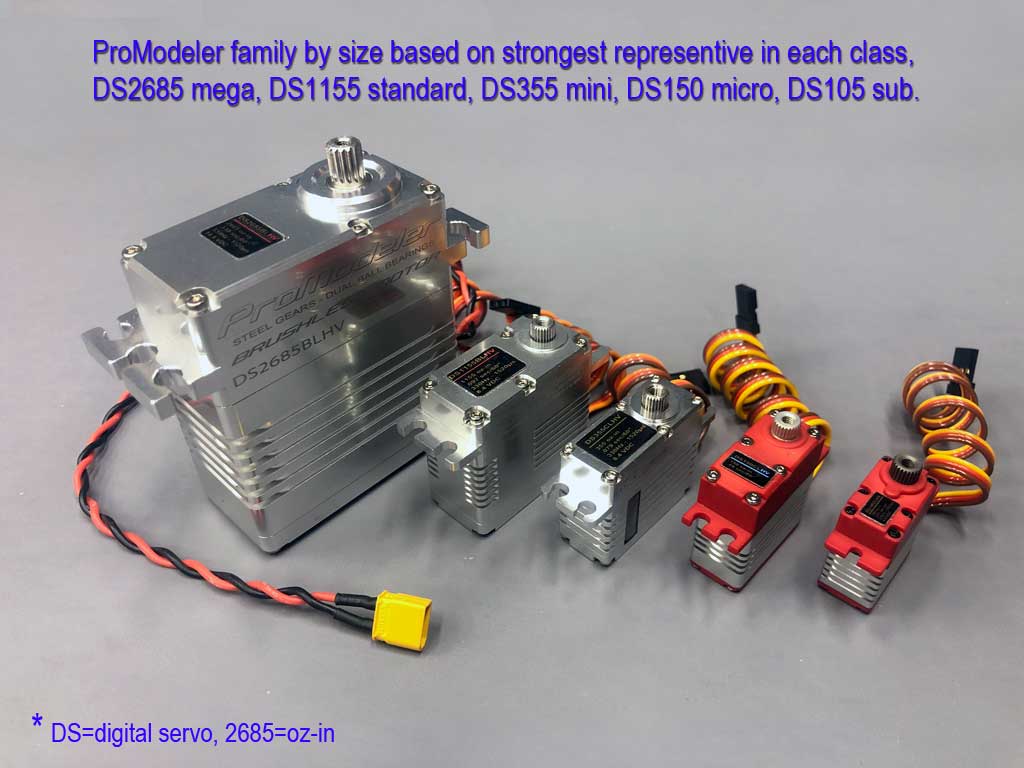
- Amongst other factors like motor and construction, servos vary by frame size

Interestingly, in theory any of the 5 should work because 90oz-in is 90oz-in regardless of the size of the servo producing it, right? Thing is, in practice, from amongst the five, one frame size is hands down the best alternative when it comes to replacing the Potenza mini that comes in the CAP 232EX 60e.


Let's delve into the thinking involved in selecting the best servo for your CAP 232EX 60e.
Factors beyond size: robustness
For example, while the ProModeler DS100DLHV outputs a bit more torque than the stock Potenza mini, it's a micro-size servo. At about 2/3 the size of a mini, a micro is considerably smaller. Means the gears are smaller, too, and this affects how robust it is.
Fitting a micro into the larger servo pocket left by by the Potenza mini requires you to shim it. Is this doable? Oh yes, absolutely, but there's some work on your part to get it right. But this doesn't change the fact the smaller gears of a micro are more fragile than the larger gears of a mini (physics). This is why I would scratch a micro off the list.
Selecting the DS105CLHV sub-micro is a similar situation in that this servo is smaller still (it's about 2/3 the size of a micro so more shimming is required). Again, shimming is easy enough but now the gears are even smaller, meaning more fragile. This, despite the fact for this servo, we switch to an all-steel gear train, which is better.
However, using a sub-micro in place of a mini is OK in some modes but definitely not for a 3D model because of their with huge control surfaces. So in my opinion, scratch the sub-micro off the list also. Anyway, since I brought up gear material, let's touch on that because this directly (along with size) affects robustness.
Gears
ProModeler don't make gears. We buy them from someone who specializes in hobbing miniature gears. They're located in China (Taiwan if we're being technical but that gets political, so enough said). Point being, while we have CNC-mills and lathe, hobbing is different and it's hard to beat a man at his own craft. These guys are the best in the world. Fact is they probably supply gears to everybody you can name! That said, gears come in different grades and may be made from different materials and we don't take shortcuts by using cheapo gear sets out of the catalog and certainly not with the ones we have custom made. Can't speak to others, understand?
Another fact is manufactures sometimes use MG within their servo-nomenclature (MG putative meaning is metal gears). However, in point of fact, they often slip a plastic gear into the stack (usually with some marketing inspired name like Kryptonite). Why? Some make specious claims about static electricity, yada, yada, but in reality it's to save money because that first gear, while it's the smallest and thinnest, as it turns out, it alone is about half the cost of the entire stack! So it's really to do with save money.
Plastic gears break, sometimes under load (as in flight). If you price replacements, you'll notice these are frequently sold in packs of three. Enough said? Anyway, there's a reason we don't use plastic gears and we won't speak to the ethics of those who do and disguise the fact with word games like MG, but heads up, OK?
Meanwhile, some manufacturers state metal gears and mean it. We do. The Potenza mini uses metal gears throughout, also. Note; there are no plastic gears in the construction of a ProModeler servo. None. Period. All our gear trains are all-metal.
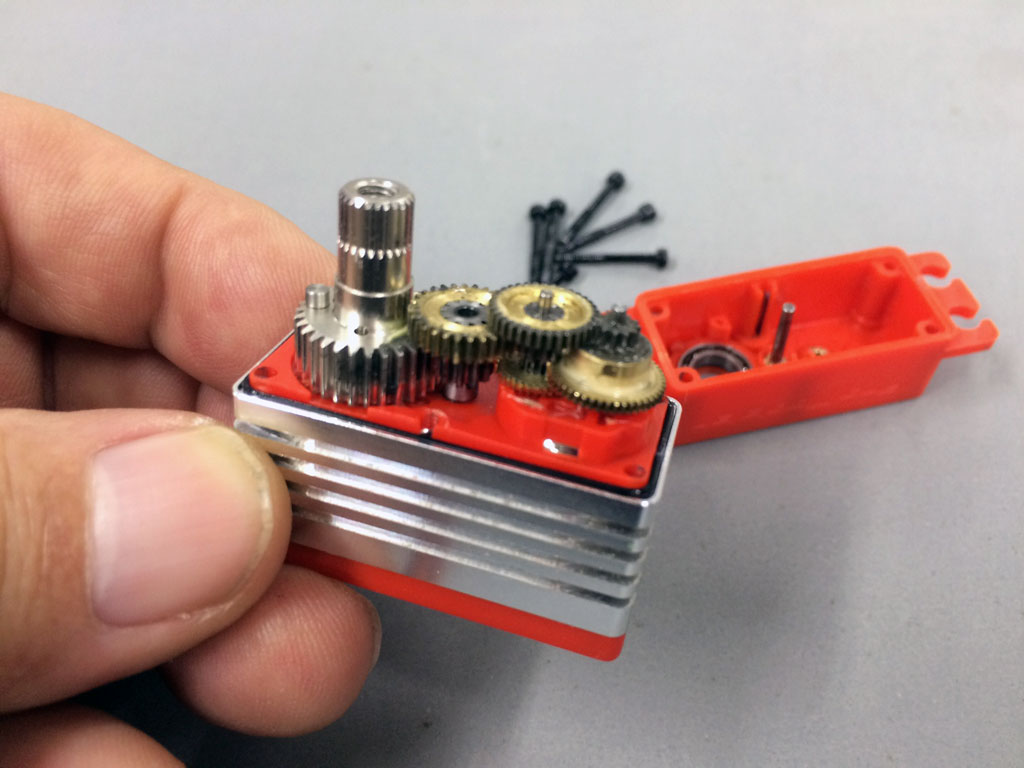
- Finely crafted all-metal gear train for the mini-class servo we're recommending

On the flip side, the DS90DLHV is a standard-class servo (a bit larger in size than a mini, which is about 2/3 the size of a standard - seeing a pattern?), and while it is rated at the same 90oz-in torque as the Potenza, being physically larger means enlarging the existing mounting pockets (instead of shimming a smaller servo to fit).
While digging out a bit of foam is totally doable, and this model will handle the added weight with ease, installing this servo is going to be more work than shimming a smaller servo because it'll likely also requires a new mount (to accept screws since they won't ever 'snug up' in foam). A major plus are the gears are a lot larger, so robustness is enhanced. And it's very inexpensive, another plus.
However, our advice is to consider selecting from one of four ProModeler mini-class servos, instead. Why? Principally because a mini replacing a mini requires very little effort because they are essentially the same size.
Using a mini means no shimming, no digging out foam to make it fit, plus reusing the same mount. Makes the job easy! Add to this, any of our mini-class alternatives would improve on the stock servo's performance. within the mini-size frame class we offer four alternatives;
- DS110CLHV
- DS160CLHV
- DS205BLHV
- DS355CLHV
. . . the later supremely capable even in 78" wingspan 3D-model, meaning one about twice as heavy as the 60e class model. These aircraft are not only larger and heavier but are usually equipped with standard-size servos, and fitting them with a mini results in a significant weight savings. But I digress.
Thinking around corners
Before discarding thoughts of the DS100DHV or DS90DLHV out of hand, particularly if it's just because installation will require a bit more work let's consider how they could work. First, the micro-size DS100 is an interesting idea, especially for an extremely gifted 3D-pilot. Why?
It's for the fact the DS100 at 25g is significantly lighter than the 34g Potenza. However, while this might be an advantage for an extremely gifted 3D pilot, for the merely good one, we'd advise against it.Why? It's because a 60e-size model probably couldn't generate forces large enough to break the gear train of a micro-size servo in the air, with such massive control surfaces we wouldn't rule it out. Added to which, pretty much inadvertent bump whilst transporting, e.g. against a door frame could easily damage it. And while a DS90 would definitely be more robust than the stock servo (because the gears are larger), you'd be adding a fair bit of mass to the airframe, which decreases performance. Point being, while I may not notice the little bit of extra weight (I'm a duffer as pilots go), a better pilot likely will notice. So scratch the DS90DLHV off the list.
So we've scratched off a sub-micro, a micro, and a standard (whilst never considering a wing-servo because of the mounting style being too different). Ultimately, we concur with Quique and the gang at Flex Innovations in that we, too, believe a mini-size servo would be the best choice for this class of model. Basically, it's because of the confluence of performance and robustness (gear size).

Note, both ours and their Potenza sport good quality metal gears the differences largely are accounted for in that our servos aren't designed to a price point. Since we're not intent on bundling our servos with a model, our focus can be on perfecting the product without regard to costs. Some may be surprised we admit it, but there's no way we can do what we do, like meet three MIL-STDS, use 13 o-rings, potting compound, bronze inserts, press fit motors, finned cases, etc. whilst trying to be competitive with servos made to be bundled. reality. Our servos are considered the best because of it. eyeball this photo to get a sense of what we mean. Disassemble one of the servos you own now and you'll immediately see what we're talking about.
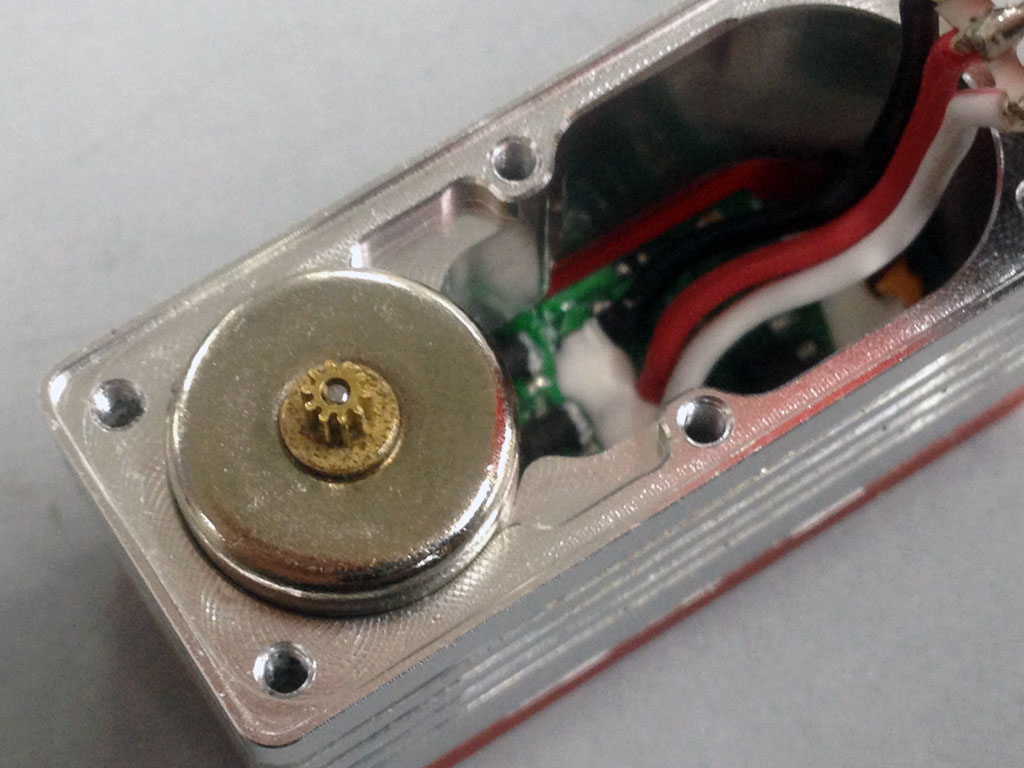
- CNC-machined 6061-T6 aircraft aluminum, press-fit motor for better cooling

Suitable ProModeler minis for the CAP 232EX 60e size model?
So while we offer four in this mini size-class, let me brief you on the differences. Our DS110CLHV is a bit stronger than the stock 90oz-in Potenza, and about 3X faster. we also use a genuine Noble million-cycle potentiometer that costs a significant fraction of what their whole servo costs! Anyway, when matched to the Aura8 gyro, due to the 0.03sec/60° sweep it makes it a great choice, maybe the best.
The DS160, however, is more than 50% stronger than the stock servo. It also is 2X faster (0.06sec/60° versus 0.12sec/60°) so it also is a great match for Aura gyros (gyros respond far quicker than flesh and blood so to optimize them, use the fastest servos you can afford). Honestly, this may be the best all around choice when matched to an Aura8. Sharing similar construction with the DS110CLHV, about 75% of our customers select this servo for their 60e size models.
Our DS205BLHV is more than 200% stronger than the Potenza (205oz-in versus 90oz-in) while being more than 2X faster (0.052sec/60° versus 0.12sec/60°) and it's equipped with a brushless motor (these last about 5X longer). It's also equipped with an all-steel gear train (better than all-metal). Add to it, this servo is built within an all-alloy case. Thus, there's a reason it's considered the Cadillac in our line up. Amongst competition pilots it's the first choice amongst the better heeled. For a foamy model? Honestly, this servo is overkill for all but those who want the best.
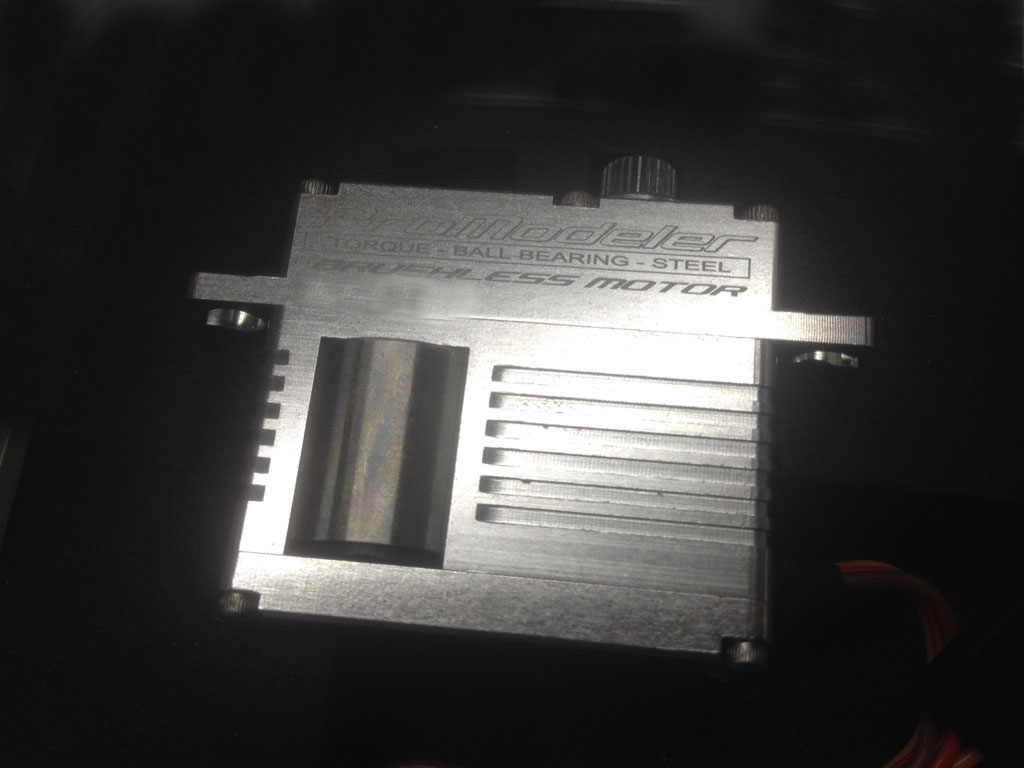
- Built within an all-alloy case, the DS005 is a superb choice for a 60e class model
Finally, there's our DS355CLHV which like the DS205BLHV is built within an all-alloy case. This mini-class servo is about 400% as powerful. Best for you? Dunno, maybe if you think about the future in which case, yes, because this servo can be used in 3D models ranging up to 78" wingspan (equipped with 12S power systems). One thing is certain, the results of installing a set of these are enough servo output to drive control surfaces for performing 'any' maneuver imaginable with a 60e size aircraft.

Closing:
All this said, most pilots are going to be best served with the DS160CLHV . . . in our
opinion. But since we don't know you, or how you fly, the decision is going to be up to you.
The DS110 being faster is really great with the Aura8 gyro but since the DS160 is faster than stock also, it's a good choice as well. The DS205BLHV is a sweetheart but pricey.
Note; some guys like the added power of the DS160 and DS205 to better correct mistakes. Meaning being able to horse the model around by force if needs be. This brings us to the DS205, considered by many as the most precise and power servo combination available to a 60e class model. In short, this servo is 'mo betta in all regards (and the price reflects this). Basically, this servo is squarely in that category of, when you want the best!
So you may be wondering about the DS355? Honestly, there's not really a perfect use case in a model like the 60e but as I mentioned we sell quite a few so maybe they're buying these whilst thinking of future applications where a 355oz-in mini would be useful. Dunno, but if that CAP232EX were my plane I'd probably get a set of DS160CLHV and then add a B2S2000 dedicated pack to ensure the BEC doesn't let me down.

Summary: servoSELECTION for a Flex Innovation CAP 232EX 60e
Quique and the crew at Flex have optimized their model for a mini-class servo and while ProModeler offer five servos matching the stock mini-class servo's 90oz-in torque (we do it with two servo smaller than stock, one of similar size, and one larger than stock), it's our opinion that one of our minis would be best for you. Within the mini class we offer one that has about the same torque but is faster (by a bunch), one that's 50% stronger (and also faster), another 200% stronger and more than 2X faster, and one that's 400% stronger. However, it's our opinion the best for the model is a toss up between the DS110CLHV and the DS16CLHV. There's a hamburger difference in price and thus, we don't think price is a factor between these.
You're looking at ProModeler because you want better. better costs so we won't apologize for our prices. Anyway, both recommended servos meet three MIL-STDS, have 13 o-rings (for if you ever fit your model with floats), have bronze inserts in the case for increased longevity, use potting compound on the PCB to help protect against vibration and shock, and center better, plus both are more powerful, and faster to boot. we've stepped through some of the considerations we take into account when selecting servos and hope this information will help better guide you next time you're selecting servos.
